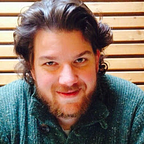About the Styling: What’s the Deal with the Armadillo and all the Yellow?
Basically It’s all about Matthew McConaughey.
So what’s the deail with the logo?
For reasons I genuinely can’t recall, I have always liked armadillos. I know I bought a small black onyx armadillo when I was 12 and dreamed of putting it on my dream car as a hood ornament, which at the time was a 1992 purple Ford Mustang (I was 12. It was the early 1990’s). But, this is more like a sign pointing to the real rationale.
When I was in high school, I was (very) left-wing, liked Armadillos, and picked up a book by Democratic Party Populist and former Texas Secretary of Agriculture Jim Hightower who famously quipped (and attractively — to me — titled a book) that “here is Nothing in the Middle of the Road But Yellow Stripes and Dead Armadillos (armadillos in a leftist book title? “Buy!”, said high school me!). His was a clear argument for more left populism, and possessed of the familiar disdainful attitude towards moderation by the political wings with a long pedigree (and a great comedy bit by Monty Python’s John Cleese in 1975). It’s not entirely undeserved. Much of moderation has been mushy milquetoast — a deeply unimaginative arithmetic mean between the wings or a ‘least common denominator’ blandness designed to be as inoffensive as possible.
But, right now we see a situation where what could conceivably constitute ‘the middle’ is large and diverse. It contains Never Trumpers, Christian democrats, classical conservatives, classical liberals, old school American liberals, the centrists in both parties The centers of gravity in American political discourse heavily favor the wings of the GOP and Democratic Party, and we know that the political parties themselves are nearly as far apart as they have ever been. Thus, on our metaphorical political road, there are very few cars coming anywhere near the middle. They are way off barely staying out of the ditches on either side. At times it can feel like I am going a little crazy. Are my choices really Trumpian anti-immigration and blatant discrimination or open borders and muscular equity (as opposed to equality) programs? Is it Medicare for all or Bust or pretty much no medical plan? Is it really a choice between unrestrained oil companies or unrestrained big tech companies? Between seering hostility to all institutional elites, to blind loyalty to traditional institutions that are seen as ‘on your side’? There is an awfully wide and productive gulf there where an entire political culture and programme could live!
This point was aptly made by one of my new favorite celebrities — Matthew McConaughey. In promoting his new book (which I recommend as an example of the kind of masterwork of integrity and wisdom in approaching life and politics) he has been giving interviews from various rooms in his house with his hair in various states of disrepair.
In at least two interviews, McConaughey, declaring himself ‘aggressively centrist’ exclaims something to the effect that “‘I’m walking down the yellow line right now, and the armadillos are running free having a great time.’ I said, ‘You know why?’ I said, ‘The other two sides, the two vehicles on either side of the political aisle are so far apart, their f****** tires aren’t even on the pavement anymore.” This particular phrasing came from his interview with Russell Brand, though I originally saw this on a different British Russell’s show, Russell Howard. (Get more names Brits.)
I like the idea of being an Armadillo running free.
McConaughey notes that both extremes are serving up unprecedented threats towards the way of life and values of many if not a majority of Americans. This view is not out-of-step with research examining the views and identifications of Americans (as soft as these studies can be). Hidden tribes find the wings comprise no more than 30% of the voting population. In December, Gallup found that 41% of American Identified as independent, 25% Republican, and 31% Democratic. Gallup’s slightly more variegated analysis finds that Independents are a mixed bag, the Democratic Party just barley majority self-declared ideologically “liberal” rather than moderate or conservative, and Republicans overwhelmingly describe themselves as “conservative”, but as we have seen battling over the soul of what exactly “conservative” even means is a major element of what is roiling the Republican Party. When we look at polarization within Congressional Chambers, it’s never been higher. Nevertheless, McConaughey’s observation is not incompatible with what we know.
Moreover, there is some nice symbolism. The yellow lines in the center of the road is the guide upon which traffic is governed. It’s what keeps cars out of the ditch and from running into each other. They sit at the median of a two lane road, and just as the median should guide politics in a representative majoritarian democracy, so should it in our political culture and discourse. While it seems now the middle has to desperately grasp to moderate the wings, in a well run democracy, it should be the wings trying to pull the middle. Indeed, there is good reason to believe that the hostility of political extremists to moderates that resurfaces every time they are in ascendents is a vengeful triumphalism of having to curry the favor of the middle for so long.
And Aesthetically yellow lines have lots going for them. And armadillos are cute. And all of it can be turned into great merch or movement iconography if anyone reads this and takes seriously a commitment to a parallel republican lifestyle. And then, whenever anyone asks ‘what’s with the armadillo and all the yellow’ when looking at your Parallel Republic mug, you can start a fine conversation about what it’s all about.
